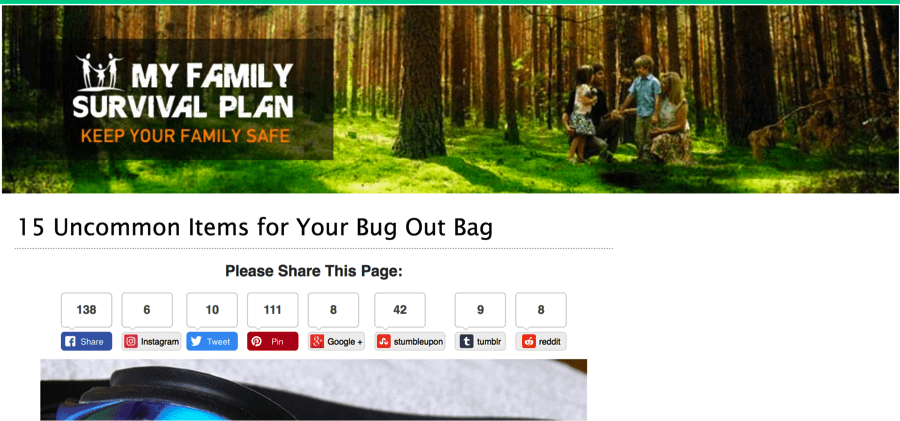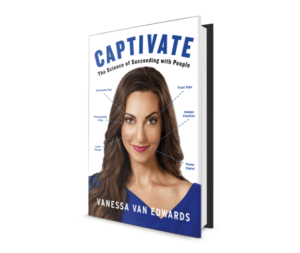Nir’s Note: This guest post is by Vanessa Van Edwards, lead investigator at the Science of People — a human behavior research lab. This exclusive book excerpt is from Vanessa’s new book, Captivate: The Science of Succeeding with People, which was recently named as one of Apple’s Most Anticipated Books of 2017.
We all want more conversions. More sign-ups, more sales, more clicks. And so we obsess over calls to action, user flow, and user-centric design. But there is one tool most entrepreneurs, web designers, branding experts, and copywriters forget to take into account—personality.
Understanding the science of personality can help attract, retain, and convert your ideal user. Before diving into how understanding personality can improve your company, it’s worth noting that there is a lot of bunk out there about personality. Myers-Briggs, DiSC, enneagram, all of those models have shown little or no peer-reviewed evidence1.
However, when it comes to established science about personality, look to what psychologists call, “The Big 5.” The Big 5 personality traits have been rigorously studied and tested for thousands of published studies. In short, this theory posits that everyone ranks high or low in 5 specific personality traits:
-
- Openness: How adventurous, creative or open to new ideas someone is.
- Conscientiousness: How organized, detail-oriented or orderly someone is.
- Extroversion: How much someone likes being around people, how outgoing and talkative someone is.
- Agreeableness: How easy going someone is, how cooperative they are and how easy it is for them to be on a team.
- Neuroticism: How much of a worrier someone is, how reactive and emotionally stable they are2
How can understanding The Big 5 help your company? By helping you connect with your ideal user.
For example, companies must cater to the needs of different customers at different phases of the business’ growth. In the early days of a new technology, for instance, you’d want to serve early adopters since attracting laggards would be a waste of your scarce time and resources.
In other cases, a company would want to tailor its marketing to reach customers most likely to find value in its products or services. Understanding your customers’ personality increases the odds of your message resonating and increases the odds of a sale.
You can use what I call personality signals to attract (or repel) an ideal user based on their personality traits. These can be images, words, colors, videos, logos and pictures on your landing pages or in your branding. Let’s identify the personality traits of your ideal user and see how you can incorporate them as personality signals into your pages:
1.Openness
Is your ideal user low or high in openness? Check off which one sounds more like your ideal user:
____Highs: Love to try new things. They want adventure and are very curious.
____Lows: Gravitate towards routine, habit, and tradition. They are cautious before trying anything new.
Case Study: Location Rebel with Sean Ogle
Sean Ogle runs a company called Location Rebel—it is a membership website and blog that helps people work virtually and hack travel. Naturally, his ideal user ranks high in openness. They crave adventure. To cater to his customers’ personality, Sean embedded personality signals for his ideal user all over his landing pages.
- Personality Signal: Header Image The top image on his header says it all—be in exotic locations, work creatively, travel. He does it with the imagery AND with the words he uses. The adventure embedded in a phrase like “work from anywhere” is like a beacon for high opens.

- Personality Signal: Video On his homepage and YouTube landing page Sean also appeals to high openness with this video. People ranking high in openness like variety and they love surprise (watch until the end of the video for the big surprise…)
Openness Signals:
Depending on your ideal user, you would want to send personality signals to attract them. If you have low open users you want to make guarantees, refund options, and payment plans highly visible. This will help a low open user feel more comfortable with risk. If you want high open users you want to call them to a sense of adventure and curiosity3.
For example, in our business, we are looking for high open users. I run a human behavior lab. We teach people skills in online courses, corporate workshops and in my latest book called Captivate: The Science of Succeeding with People. My ideal reader is a high achiever, loves data, is intensely curious and hates touchy-feely stuff. So I have to cater my brand, my website and my curriculum to them. I specifically signal openness. When we changed our call to action button from “Register” to “Start Learning” we increased our opt-in rate by 14%!

2. Conscientiousness
Is your ideal user low or high in conscientiousness? Check off which one sounds more like your ideal user:
____Highs: Love lists, details, formulas and organization.
____Lows: Love big ideas, strategy, and free flow.
Case Study: GitHubEngineers, programmers, and developers tend to be high in conscientiousness—they need to be detail oriented and have programmatic thinking. One small error can mess up entire lines of code. Github is a software development platform and their landing page celebrates details and high conscientiousness just as much as it celebrates programmers.
- Personality Signal: Pain Point One of the pain points Github both visually and verbally highlights is “Manage your chaos.” This phrasing is like manna from heaven for a high conscientious person. And look at the visual of moving from free flow into order:

- Personality Signal: Verbal Github uses words that attract high conscientious people. Some of their headers include: “Boxes? Check.” And high conscientious people love checking off items on a to-do list. And their big call to action is “Perfect the way you work.”
- Personality Signal: Specific Social Proof Instead of saying ‘millions of users’ Github actually gives precise numbers—a great signal for detail oriented users.

Conscientiousness Signals:
Here’s the easy thing to remember with conscientiousness—highs love details because it makes them feel secure and precise. Lows are overwhelmed by details. They prefer big ideas and broad strokes4.
You should only signal conscientiousness if you know it is an important trait for your users to successfully use your product. For example, of you are not detail oriented you are not going to have an easy time programming on Github. If you have a product that involves lots of steps, tracking and precision you want to make sure you are signaling that to high conscientious users. If your product is more creative, free flowing and non-precise you would like users who are more exploratory and ok without checklists or steps.
3. Extraversion
Is your ideal user low or high in extraversion? Check off which one sounds more like your ideal user:
____Highs: Love people, is very outgoing, talkative and sociable.
____Lows: Loves alone time, is more reserved, private or shy.
Case Study: Quiet Revolution with Susan Cain
Susan Cain ushered in the quiet revolution—going after low extraversion individuals by helping them own their quiet power. She wants to signal solitude, calm, peace and quiet. Here’s how she does it:
- Personality Signal: Landing Page When you first get to her homepage you are greeted with a variety of rotating calming images—running water, rocks in a pond or a painting. No people, no groups, no laughing colleagues:

- Personality Signal: Brand Words Susan Cain has taken power from the word ‘quiet’ and integrated it into her brand as a personality signal for introverts. Her website pages are called things like, “Quiet Ambassadors,” “Quiet Schools” and “Quiet Revolutionaries.” That will not appeal to a loud extrovert—and that’s on purpose.
Extraversion Signals:
If you are trying to appeal to low extraverts you want to send the message of: “You’re safe here.” This can be done with imagery, promises, and words. On the other hand, if you have high extraversion users and want to convert them you have to appeal to their desire to “Be safe with others.” For extraverts you want to highlight a sense of community, meeting great people and tribe membership.
4.Agreeableness
Is your ideal user low or high in agreeableness? Check off which one sounds more like your ideal user:
____Highs: Is a great team member, defaults to saying yes to everything and is very easy going.
____Lows: Is more analytical, defaults to saying no to most things, scrutinizes ideas and is more skeptical.
Case Study: Good Life Project with Jonathan FieldsAs soon as you get to the Good Life Project homepage you are overwhelmed with signals of high agreeableness. It is all about getting along, finding your people, and saying yes to everything. That helps Jonathan Fields get the perfect kind of user to his camps, the perfect kind of reader for his books and the perfect kind of student to his programs.
- Personality Signal: Images Almost every image on Jonathan Fields landing pages are with people holding hands, hugging each other and getting along.

- Personality Signal: Tribe Behavior All Good Life Project Campers call themselves Gleepers—gleefully so as it is a mark of being part of a team or group. Remember for agreeableness group identity is more emphasized than individual identity. They also prominently feature a community “Creed” prominently on their landing pages.
Agreeableness Signals:
If team, community, and having a tribal identity are important for your brand, you want to signal that to highly agreeable people. On the other hand, my ideal readers are typically low agreeable so they love data, facts and academic research. For my book, Captivate, instead of emphasizing a community (which feels far too fluffy for my readers) I talk about our large database of academic studies—currently over 3,200 and our science-based tips.
5. Neuroticism
Is your ideal user low or high in neuroticism? Check off which one sounds more like your ideal user:
____Highs: Is a worrier, is more moody and reactive.
____Lows: Is emotionally stable, rarely has mood changes and typically feels calm.
Case Study: Preppers
There is no better example of high neurotics—and brands that appeal to high neurotics than the world of preppers. Prepper websites love to capitalize on the constant worry of high neurotics to increase conversions. There are two ways they do this:
“Don’t worry, we will help” or “Worry and buy quick!”
For example, MyFamilySurvivalPlan.com goes for the calm route.
- Personality Signal: Header Their header is a serene picture of a family in a forest—living and foraging with bliss in presumably a post-apocalyptic world. Even their logo is a small family holding hands.

On the other hand, SurvivalPulse.com appeals to high neurotics by freaking them out more. Well, not quite. They (very cleverly) created a landing page where they have already gone under ground and are withholding information about why. The ominous black and white picture in the background doesn’t help reassure.

But Survival Pulse does not want to calm you down. They want to make their high neurotics more anxious—so they sign up.
- Personality Signal: Doom & Gloom Notice how there is no color on this header. They use a dark, lonely picture. Then they say they have gone underground. That is a prepper high neurotic’s worst nightmare. You can bet they will sign up to find out why.
Neuroticism Signals
Low neurotics believe “everything will be fine.” They are the ones who look at preppers and think, “That will never happen and even if it does, things will always work out.” On the other hand, high neurotics are constantly worried that nothing will work out at all5.
You want to think about how you attract high and low neurotics specifically around pain points. If you have a high neurotic you want to talk about how your product or service will solve their worries for them. If you have a low neurotic you want to appeal more to the benefits—they are less worried about pain, and more on the lookout for improvement.
Your Call to Action:
Designing the perfect landing page is hard. Even with advanced analytics tools, tons of data and months of tweaking it can be hard to get it right. Personality science is a tool that will make it easier.
Special Note: You do NOT have to signal every personality trait! If you try to signal all 5 it will be too confusing. You just want to signal the ones that help your ideal user more effectively adopt your brand. I like to pick the top 2 and focus on those in the first few minutes of a users experience.
- What are the top 2 personality trait rankings that are an essential aspect of your ideal user?
- How can you signal these traits to them?
- Do your images, calls to actions, headers, and descriptions signal the right personality rankings?
To read more about the 5 personality traits and how to integrate them into your brand and your relationships please check out my book: Captivate: The Science of Succeeding with People.
[1] Eveleth, Rose. “The Myers-Briggs Personality Test Is Pretty Much Meaningless.”Smithsonian.com. Smithsonian Institution, 26 Mar. 2013. Web. 10 Mar. 2017.
[2] Jerry S.Wiggins, Five-Factor Model of Personality: Theoretical Perspectives (New York: Guilford Press, 1996).
[3] John M.Digman,“Personality Structure: Emergence of the Five-Factor Model,” Annual Review of Psychology 41, no. 1 (February 1990): 417–40.
[4] Gerald Matthews, Ian J. Deary, and Martha C. Whiteman, Personality Traits (Cam- bridge, UK: Cambridge University Press, 2003).
[5]Donald Winslow Fiske, Patrick E. Shrout, and Susan T. Fiske, eds., Personality Research, Methods, and Theory: A Festschrift Honoring Donald W. Fiske (Hillsdale, NJ: L. Erlbaum Associates, 1995).
Related Articles
- Schedule Maker: a Google Sheet to Plan Your Week
- Cancel the New York Times? Good Luck Battling “Dark Patterns”
- How to Start a Career in Behavioral Design
- A Free Course on User Behavior
- User Investment: Make Your Users Do the Work
- Variable Rewards: Want To Hook Users? Drive Them Crazy
- The Hooked Model: How to Manufacture Desire in 4 Steps

